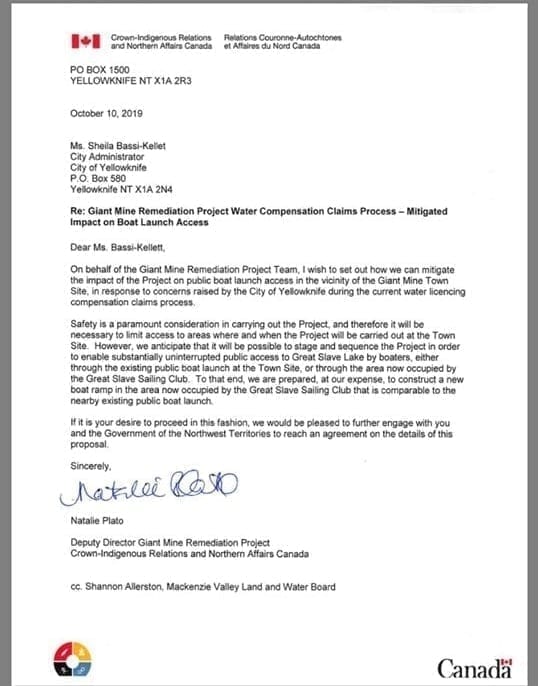Amid concerns about how the Giant Mine Remediation Project will impact water access in Yellowknife, the federal government is proposing to build a new boat launch at the current Great Slave Sailing Club site.
In a letter sent to the City of Yellowknife from Crown-Indigenous Relations and Northern Affairs Canada (CIRNAC) — the department tasked with heading the remediation and decontamination project alongside the GNWT — Natalie Plato, deputy director of the Giant Mine Remediation Project, suggests constructing a “new boat ramp in the area now occupied by the Great Slave Sailing Club that is comparable to the nearby existing public boat launch.”
The proposal, according to the letter obtained by Yellowknifer, is part of an effort from the federal government to reduce the project’s impact on access to Great Slave Lake near the old Giant Mine town site — a response to concerns raised by the city and residents in the boating community.
For the project to be carried out safely, limiting access to areas around the site is necessary, the letter states. The department believes it will be possible to “stage and sequence,” remediation work to ensure “substantially uninterrupted” public access to the lake by boaters.
The feds would foot the bill for the new ramp, the letter states.

Ian McCrea, a long-time member of the Great Slave Sailing Club, sees the proposal as a promising step in the right direction.
“We have reason to be optimistic about the future now. We're thinking this could be good news,” said McCrea.
While the details of the proposal aren’t laid out in the letter, McCrea told Yellowknifer he’s had meetings with both the Giant Mine Remediation Project Team and the GNWT.
It’s McCrea’s understanding that if the feds’ proposal - which, he said, would reduce interruptions to access at both the club property and the public boat launch - pans out, the remediation work would begin at the site currently occupied by the Great Slave Sailing Club.
Once work at the club site begins - he speculates that won’t happen until 2023 - McCrea said it’s hoped most sailboats on site will be moved further up the property - some 200 yards - while the remediation work is carried out. Larger boats that can’t remain in the area, he said, will have to be moved into storage, either locally or elsewhere.
Then, during each sailing season affected by work at the club property, Great Slave Sailing Club members will move their boats up to the public boat launch to access the lake, said McCrea.
Once work at the club property is complete, members would then bring their boats back to the site as remediation begins in the area of the public boat launch.
“We would relocate our property in a way that the public would also be able to go there and use the new boat launch when they shut down access to the public boat launch,” said McCrea.
From his talks with the feds and the GNWT, McCrea said closures to the public site will take place over a two-phase, multi-year period to mitigate continuous interruption of access.
“If it works out well, everybody will be able to get their boats in and out during the entire course of the remediation,” said McCrea.
McCrea’s optimism - a far-cry from the “doom and gloom” the club was experiencing earlier this year - is the result of increased confidence in the federal and territorial government.
“I think they’re both cognizant of the challenges that we and the public face at our club property and the boat launch property,” he said.
“When it initially came out there was so little known, we felt threatened, maybe we would no longer have a club,” added McCrea.
He said recent developments and talks with government officials have cleared up some of the many uncertainties that initially surrounded the project and its impact on the club.
McCrea said he’s confident the Giant Mine Remediation Project Team will be able to accommodate both his fellow club members and the general public during remediation.
But McCrea said he’s aware of some of the headaches that could arise, from moving and storing boats to grappling with limited parking space at the sailing club site.
“Absolutely we’re going to be a bit short on space for parking. But I think the willingness of the federal government and GNWT to work out something that’s going to minimize the impact indicates they will be willing to work with us in order to reduce that impact. The best we can hope is to reduce the impact. I’d like to think that one way or another we’re going to be able to deal satisfactorily with that,” said McCrea.
Some uncertainties remain.
McCrea said the “big question,” in the minds of many at the club is related to the City of Yellowknife and its stance on the site.
“The city hasn’t made a firm statement to the effect that they support the return of our club to that property.”
McCrae stressed that doesn’t mean the city opposes the idea, only that it creates an “element of uncertainty,” with respect to the city’s position.
A request for comment from the city was not immediately returned before press time Tuesday.

Full story to come.